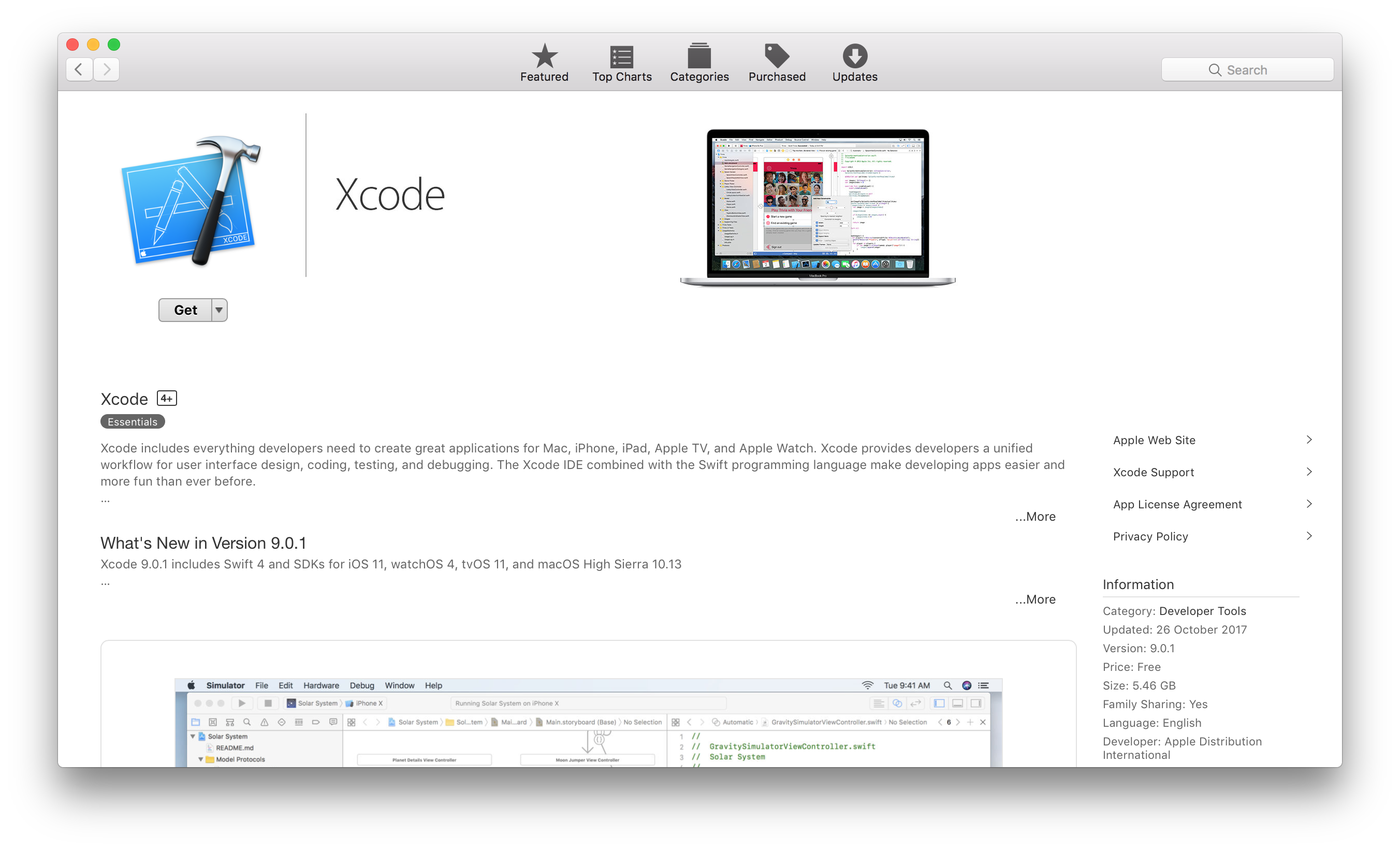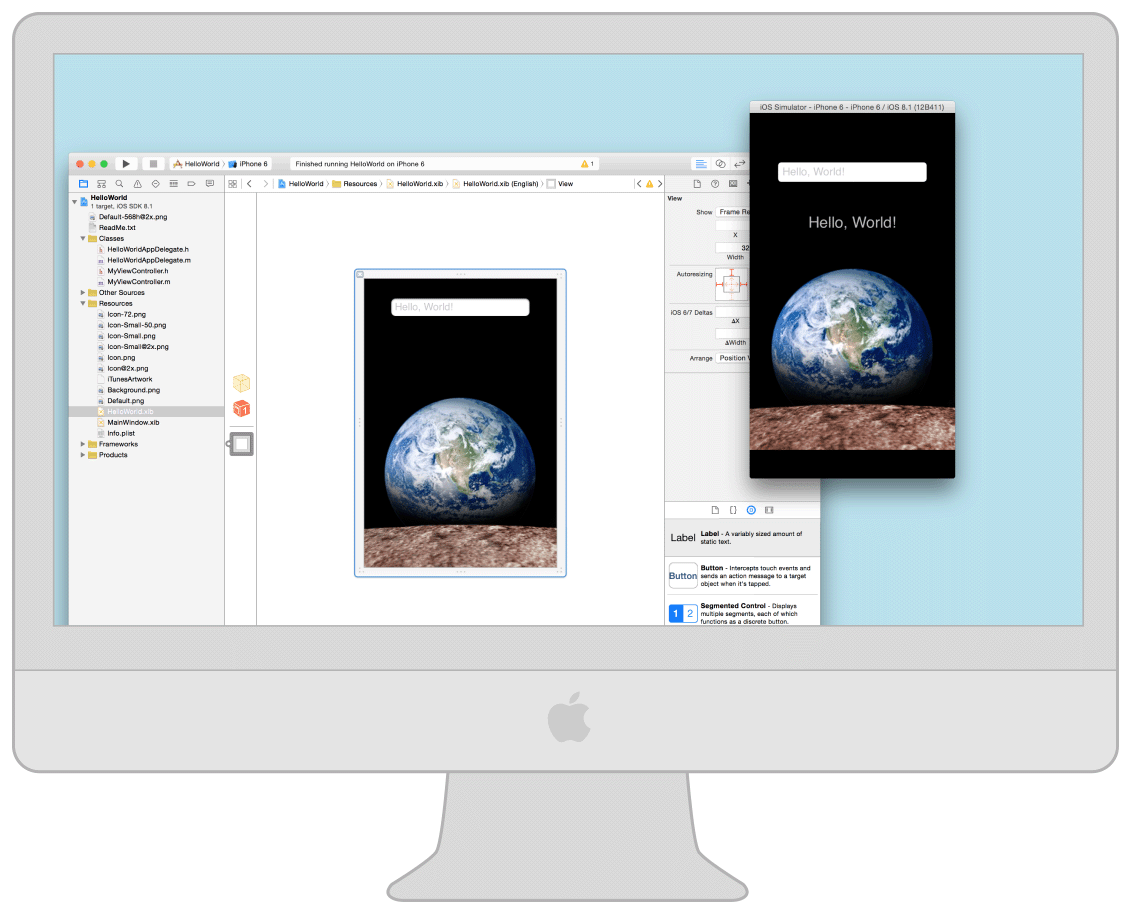Emulator games will run smoothly on just about all of Apple’s latest 64-bit devices with a steady 50-60 frames per second. Obviously, this depends on the game and the device, but Apple’s iPhone 6s or iPad Pro will run games with butter-smooth fluidity with no questions asked. Apple’s homegrown Xcode software development environment for Mac comes with its own app simulator for iOS, tvOS, watchOS, and iMessage. So, if one is using Xcode as the primary app development.
Important:The information in this document is deprecated in Xcode 9. For Xcode 9 and later, see Simulator Help by choosing Help > Simulator Help in Simulator.
Simulator app, available within Xcode, presents the iPhone, iPad, or Apple Watch user interface in a window on your Mac computer. You interact with Simulator by using the keyboard and the mouse to emulate taps, device rotation, and other user actions.
The chapter presents the basics of using Simulator. You can perform these steps using your own iOS app or, if you do not have an app to use, with the HelloWorld sample code. For more detailed information on interacting with Simulator and using it to test and debug your apps, refer to the later chapters in this guide.
Access Simulator from Xcode
There are two different ways to access Simulator through Xcode. The first way is to run your app in Simulator, and the second way is to launch Simulator without running an app.
Running Your iOS App
When testing an app in Simulator, it is easiest to launch and run your app in Simulator directly from your Xcode project. To run your app in Simulator, choose an iOS simulator—for example, iPhone 6 Plus, iPad Air, or iPhone 6 + Apple Watch - 38mm—from the Xcode scheme pop-up menu, and click Run. Xcode builds your project and then launches the most recent version of your app running in Simulator on your Mac screen, as shown in Figure 1-1.
Note: If you are testing an app with a deployment target of iPad, you can test only on a simulated iPad. If you are testing an app with a deployment target of iPhone or universal, you can test on either a simulated iPhone or a simulated iPad.
Running Your watchOS App
To run your WatckKit app, choose a combination of an iOS device and watchOS device from the Xcode scheme pop-up menu. For example, to run the watch app in a 38mm watch paired with an iPhone 6, choose 'iPhone 6 + Apple Watch - 38mm' from the scheme pop-up menu.
Running the WatchKit target launches two simulators, one for the iOS device and one for the watchOS device. Figure 1-2 shows an iPhone 6 and a 42mm watch running in two different simulators.
Running Your tvOS App
To run your tvOS App, choose a tvOS device from the Xcode scheme pop-up menu. Running the tvOS target launches the most recent version of your app in a simulated new Apple TV device, as shown in Figure 1-3.
Launching Simulator Without Running an App
At times, you may want to launch Simulator without running an app. This approach is helpful if you want to test how your app launches from the Home screen of a device or if you want to test a web app in Safari on a simulated iOS device.
To launch a Simulator without running an app
Launch Xcode.
Do one of the following:
Choose Xcode > Open Developer Tool > Simulator.
Control-click the Xcode icon in the Dock, and from the shortcut menu, choose Open Developer Tool > Simulator.
To launch a watchOS Simulator without running an app

Launch Xcode.
Do one of the following:
Choose Xcode > Open Developer Tool > Simulator (watchOS).
Control-click the Xcode icon in the Dock, and from the shortcut menu, choose Open Developer Tool > Simulator (watchOS).

Simulator opens and displays the Home screen of whichever simulated device was last used.
View the Installed Apps
From the Home screen, you have access to all of the apps that are installed in the simulation environment. There are two ways to access the Home screen in Simulator from your app:
Press Command-Shift-H.
Choose Hardware > Home.
Use the installed apps to test your app’s interaction with them. For example, if you are testing a game, you can use Simulator to ensure that the game is using Game Center correctly.
iOS Device Home Screen
Much like the Home screen on an iOS device, the simulator’s iOS Home screen has multiple pages. After clicking the Home button (or accessing the Home screen through the Hardware menu), you arrive at the second page of the Home screen. To get to the first page, where all of the preinstalled apps are found, swipe to the first Home screen by dragging to the right on the simulator screen.
On the Home screen, you see that all of the apps that have been preloaded into Simulator. See iOS Device Home Screen.
The apps that you see on the Home screen are specific to the iOS device simulation environment. Because Passbook and the Health app are available only for the iPhone, these apps don’t appear if you are simulating a legacy device or an unsupported device type.
watchOS Device Home Screen
The Home screen for a simulated watchOS device behaves the same as it would on an actual device. You can click and drag to simulate the finger dragging around the screen and launch an app by clicking on it. Figure 1-4 shows the home screen of a 42mm watch with a developer app, the Lister sample code.
Use Safari to Test Web Apps
From the Home screen, you can access Safari within Simulator. Use Safari to test your iOS web apps directly on your Mac.
From the Home screen, click Safari.
In the address field in Safari, type the URL of your web app and press the Return key.
If your Mac is connected to the Internet, it displays the mobile version of the URL you specified. For example, type apple.com into the address field and press Return. Safari displays the Apple website. See Figure 1-6.
Use Maps to Simulate Location Awareness
Simulator provides tools to assist you in debugging your apps. One of the many features you can debug in Simulator is location awareness within your app. Set a location by choosing Debug > Location > location of choice. The menu has items to simulate a static location or following a route.
A simulated watchOS device with the location set to None checks the paired iPhone device for the location.
You can specify your own location, which can be seen in the Maps app.
From the Home screen, click Maps.
Choose Debug > Location > Custom Location.
In the window that appears, type the number
40.75in the latitude field and the number-73.75in the longitude field.Click OK.
Click the Current Location button in the bottom-left corner of the simulated device screen.
After completing this task, notice that the blue dot representing your location is in New York, NY, near the Long Island Expressway, as shown in Figure 1-7.
Change the Simulated Device and OS Version
Simulator provides the ability to simulate many different combinations of device type and OS version. A device type is a model of iPhone, iPad, or Apple TV. Some iPhone devices can also have a paired Apple Watch. Each device-OS combination has its own simulation environment with its own settings and apps. Simulator provides simulators for common device-iOS, device-watchOS-iOS device, and device-tvOS combinations. You can also add simulators for a specific combination you want to test. However, not all device type and OS version combinations are available.
Note: To test apps for the iPad mini, use a simulated iPad with the same pixel resolution as the iPad mini.
You can switch between different device-OS combinations. Switching closes the window for the existing device and then opens a new window with the selected device. The existing device goes through a normal OS shutdown sequence, though the timeout might be longer than the one on a real device. The new device goes through a normal OS startup sequence.
To change the simulated device
Choose a Hardware > Device > device of choice.
Simulator closes the active device window and opens a new window with the selected device.
If the device type and OS version combination you want to use is not in the Device submenu, create a simulator for it.
To add a simulator
Choose Hardware > Device > Manage Devices.
Xcode opens the Devices window.
At the bottom of the left column, click the Add button (+).
In the dialog that appears, enter a name in the Simulator Name text field and choose the device from the Device Type pop-up menu.
Choose the OS version from the iOS Version pop-up menu.
Alternatively, if the iOS version you want to use isn’t in the iOS Version pop-up menu, choose “Download more simulators” and follow the steps to download a simulator.
Click Create.
If the OS version you want to use is not installed, download it and follow the steps to add a simulator again.
To download a simulator
In Xcode, choose Xcode > Preferences.
In the Preferences window, click Downloads.
In Components, find the legacy simulator version you want to add, and click the Install button.
You can also delete and rename simulators in the Devices window.
To delete a simulator
In Simulator, choose Hardware > Device > Manage Devices, or in Xcode, choose Window > Devices.
Xcode opens the Devices window.
In the left column, select the simulator.
At the bottom of the left column, click the Action button (the gear next to the Add button).
Choose Delete from the Action menu.
In the dialog that appears, click Delete.
To rename a simulator, choose Rename from the Action menu and enter a new name.
For how to manage real devices that appear in the Devices window, read Devices Window Help.
Alter the Settings of the Simulated Device
You can alter the settings within Simulator to help test your app.
On a simulated device, use the Settings app. To open the Settings app, go to the Home screen and click or on tvOS, choose Settings. In Figure 1-8 you see the Settings app as it appears when launched in the iOS simulation environment.
The Simulator settings differ from the settings found on a hardware device. Simulator is designed for testing your apps, whereas a hardware device is designed for use. Because Simulator is designed for testing apps, its settings are naturally focused on testing, too. For example, in a simulated iOS device the Accessibility menu provides the ability to turn on the Accessibility Inspector, and the Accessibility menu on a device allows you to turn on and off different accessibility features.
Through the settings, you can test both accessibility and localization of your app. See Testing and Debugging in iOS Simulator for information on how to manipulate your settings for the various types of testing you are interested in.
Remember: Changes made in the Settings app of simulated device affect only the simulation environment that is currently running.
Rotate iOS Devices
You can use Simulator to manipulate the simulated device much as you do a physical device.
To rotate your simulated device, choose Hardware > Rotate Left. When you rotate your simulated device, Settings rotates (see Figure 1-9), just as it would on a hardware device.
Test in Simulator and on a Device
Simulator is designed to assist you in designing, rapidly prototyping, and testing your app, but it should never serve as your sole platform for testing. One reason is that not all apps are available in the simulator. For example, the Camera app is available only on hardware devices and cannot be replicated in the simulator.
In addition, not all bugs and performance problems can be caught through testing in Simulator alone. You’ll learn more about performance differences in Testing and Debugging in iOS Simulator. You can also find more information on testing your app on a device in Launching Your App on Devices in App Distribution Guide.
Quit Simulator
Simulator continues running until you quit it. Quitting Xcode will not close Simulator because they are separate applications. Similarly quitting simulator will not close Xcode.
To quit Simulator, choose Simulator > Quit Simulator. The device is shut down, terminating any running apps.
Note: Both Simulator and watchOS Simulator can be open at the same time.
Copyright © 2018 Apple Inc. All Rights Reserved. Terms of Use | Privacy Policy | Updated: 2018-02-15
Testing IOS apps are a task compare to Android apps testing, because of very few IOS emulator available as compare to android emulators available in the market. Due to Android emulators, we quickly test, run and execute Android apps on Windows, MAC and Linux computer. Hence, to test IOS apps for iPhone, iPad very few alternatives are available. Here, I listed various IOS emulator including cloud-based IOS emulator.
In the previous post, you will get an iPadian simulator, thebest ios emulators for PC to run IOS apps on Windows PC. iPadian also used to run ios apps on Linux computer. To get more details about iPadian check how to install iPadian on Windows PC.
List of The Best IOS Emulator For PC.
- App.io
- Appetize.io
- Xamarin Testflight
- Smartface
- Air iPhone
- MobiOne
- Ripple
- iPad simulator
- iDOS Emulator
- iPadian
- iMAME
Best IOS emulator for PC
In this post, you will get iOS emulators list that helps to not only test IOs apps but also run IOS application on the different platform. Buying MAC computer just to check IPA file is expensive work. This guide gives you a solution using cloud-based iOS emulator and using iOs simulators. These emulators are work on any OS like Linux, MAC OS, Chrome OS and most common operating system Windows 7/8/8.1.
Read free international calling app for iPhone.
App.io
Amongst all IOS emulators, APP.io is the simplest IOS emulator. You need to do a simple thing that is just uploaded IOS app file on App then you can test it from any location using your Windows PC / MAC PC or Linux machine. It is a pure cloud-based system that works as a platform as a service (PaaS) and Software as a service (SaaS). Thus you can access and modified IPA file even from Android phone without any extra hardware (IOs emulator for Android APK).
Appetize.io
If you are not happy with App.io then Appetize.io is alternative for App.io IOS emulator for Windows PC. It is also a cloud-based service which provides you with a free live demo. Check 60-second free IOS emulator for PC demo. In this demo you can set screen width, iPhone model like iPhone 5, 5s, 6,6s, 6s plus,7 and iPad. Even you can select IOs version 8.4 to IOs 10. But, you cannot install any IOS app in the demo version. If you want to test your .ipa file, then upload .zip or .tar file with your IPA bundle and submit your email address. The appetizer will generate link and mail to your inbox.
Xamarin Testflight
Xamarine is another IOs emulator, which has the functionality to test and run IOs apps. It offers professional tool Testflight, Xamarin Testflight is now own by Apple. Xamarine is helping you to take a beta test on your IOs apps. It is accessible only through iTunes.
It provides interface on Windows PC so that you can use IOs apps on Windows. Xamarine has the best debugging option to recheck and rectify errors from IOs application. Check Xamarin Test flight guides. It is a complete guide which specifies each and every detail about Xamarine.
Check:Best Business App For iPhone

Smartface Emulator
The Smartface is a multi-platform emulator software to use to apples restriction and limitation. It is one of the best iPad emulators, or we can say that, an iPad emulator. It is multi-talented software to the developer. With the help of Smartface, you can run IOS as well as Android application on Windows computer like the clash of clans games on Windows PC. So, it is not only IOS but also best android emulator. It is IOs emulator for windows like blue stacks emulator for android.
Most important is you can use Smartface as an iOs tester. It makes it easy to test IOs application, a lot easier to develop and debug iOS games on a Windows PC. It supports to all IOs versions and all iOS gadgets like iPad,iPhone and even Apple TV. The key features of Smartface are listed below.
- JavaScript library.
- Single JavaScript code base.
- WYSIWYG Design editor.
- Testing apps and debugging.
- Enterprise plugins and services.
- Plugins support.
Smartface is one of the free IOs emulators for Windows PC. To get maximum feature within $99 is not a bad Deal. Check the free version of Smartface Emulator download here, If like then get the original premium version from here.
Download: Camscanner For PC
Air iPhone Emulator
Air iPhone Emulator is a simple software to use iOS apps on PC. It gives you, iPhone feeling on Windows PC. It produces an iPhone-like the graphical user interface to access iMessage on PC or Facetime on Windows Computer. This IOs emulator not only provides testing facility but also gives you real IOs feeling on Windows PC. So, if you are looking for virtual iPhone on PC, then Air iPhone is the best option. It is one of the alternatives for Bluestacks on Windows PC.
MobiOne IOS emulator
MobiOne is an all in one emulator. It has good review iOS emulator for Windows. It’s like Android SDK, gifting all in one development studio and also create complete development in one place. You can set up and test multiple iOS applications like Tube free within a unique environment. The premium version of MobiOne Studio is available in just $99.99.
Yes! MobiOne IOs Emulator also gives you a 15-day free trial version. Highly recommended Trial Version before going to a Premium version of Mobione emulator.
Ripple Chrome extension
It is multi-platform emulator which also support IOs, Android and Windows. Ripple is browser based application development and testing tool. It focused on WebWorks, PhoneGap and mobile testing and development. It supports Javascript, HTML5, automated testing and Html DOM inspection and also, shows his best performance while testing GPS function. But, it is in beta version so in the development phase. Download Ripple Chrome extension from here.
Read:How to Transfer Music from iPhone to iPhone without iTunes
Solution -: If iPhone Cannot Connect to iTunes.
Ipad simulator
Emulate Ios On Macbook
It is a Google Chrome extension like a ripple that works on cloud OS with Chrome browser. It gives you virtual iPhone and an iPad interface on your PC. So, With the help of this extension, you can use send iMessages to your friend without iPhone. If you don’t want to spend $500 on iPad, then it is the last option. Check best features of extension are:
- You can use Siri without iPhone or iPad.
- It is cloud based.
- Mobility.
- Single click connection.
- Create unlimited pages of apps
- Simple interface
- Drag and drop option.
- Multi-tasking is available.
- Best search and browse facility
- You can use screensavers.
- HD animated background
iDos Emulator – Dos based IOs emulator
iDOS/DOSPad is used DOSBox, version 0.74. It is a DOS-emulator which makes DOSBox very easy to port to different platforms. Developed and design by DOSBox Team.So, DOS Pad aims to make DOS game playing enjoyable on iMachine. That means you will get smooth game control and optimise DOS Box for iOS devices.
Download Links

iMAME for IOS
The free MAME game emulator available on the App Store is called iMAME. It is like Bluestacks for IOs, MAME is a multiple arcade free and open source machine emulator that will run lots of arcade games.
It is similar like iDos IOS emulator, iMAME is free IOs emulator available on the App Store. [Link].
Final verdict
Emulate Ipad On Mac Keyboard
Nowadays, IOS app testing is not that much difficult thanks to IOS emulators. Here, we suggest and filter some emulator, If you know other than above IOS emulator feel free to comment.